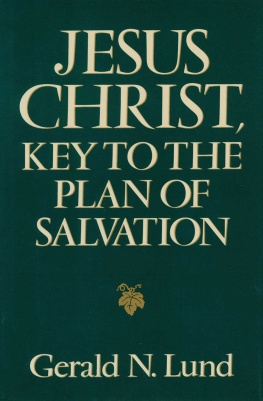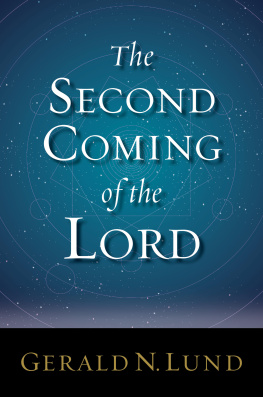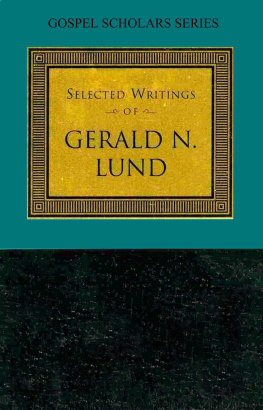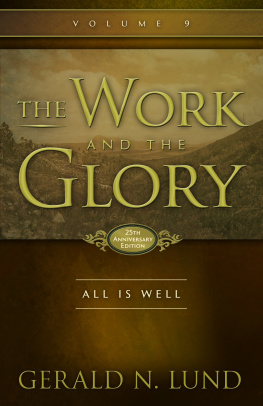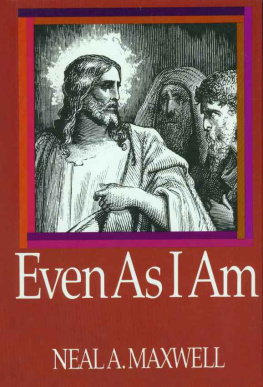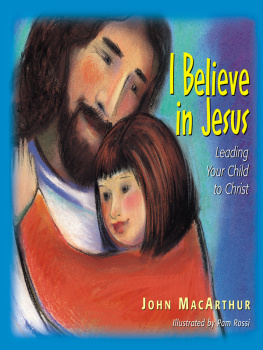Jesus Christ, Key to the Plan of Salvation
Gerald N. Lund
2012 Gerald N. Lund.
All rights reserved. No part of this book may be reproduced in any form or by any means without permission in writing from the publisher, Deseret Book Company, P.O. Box 30178, Salt Lake City Utah 30178. This work is not an official publication of The Church of Jesus Christ of Latter-day Saints. The views expressed herein are the responsibility of the author and do not necessarily represent the position of the Church or of Deseret Book. Deseret Book is a registered trademark of Deseret Book Company.
Acknowledgments
Acknowledgments
Chapters 2, 4-6, 8, 10-13 have been adapted from the following articles:
"Do the scriptures give any indication as to what happened to the family of Jesus after his death and resurrection?" September 1975, Ensign (c) The Church of Jesus Christ of Latter-day Saints. Used by permission.
"An Exploration of the Process of Faith As Taught in the Book of Mormon," in The Second Annual Church Educational System Religious Educators' Symposium: A Symposium on the Book of Mormon, August 17-19, 1978 (c) The Church of Jesus Christ of Latter-day Saints. Used by permission.
"Old Testament Types and Symbols," in The Third Annual Church Educational System Religious Educators' Symposium: A Symposium on the Old Testament, August 16-18, 1979 (c) The Church of Jesus Christ of Latter-day Saints. Used by permission.
"Salvation: By Grace or by Works?" April 1981, Ensign (c) The Church of Jesus Christ of Latter-day Saints. Used by permission.
"To This End Was I Born," in A Symposium on the New Testament, 1984 (c) The Church of Jesus Christ of Latter-day Saints. Used by permission.
"The Savior said that we should be perfect, even as he and our Father in Heaven are perfect. (See 3 Ne. 12:48.) Are we expected to achieve perfection in this life? If so, how can I avoid becoming discouraged with myself as I try to achieve it?" August 1986, Ensign (c) The Church of Jesus Christ of Latter-day Saints. Used by permission.
"Reflections on the Christmas Story," in A Celebration of Christmas (c) 1988 Deseret Book Company.
"The Fall of Man and His Redemption," in The Book of Mormon: Second Nephi, The Doctrinal Structure (c) 1989 Religious Studies Center, Brigham Young University. Used by permission.
"Divine Indebtedness and the Atonement," in The Book of Mormon: The Book of Mosiah, Salvation Only Through Christ (c) 1990 Religious Studies Center, Brigham Young University. Used by permission.
Chapter 1
"No Other Name" (Mosiah 3:17)
"Wherefore, thou shalt do all that thou doest in the name of the Son, and thou shalt repent and call upon God in the name of the Son forevermore." (Moses 5:8; italics added.) So spoke the angel to Adam at the beginning of the world's history. And thus spoke the Lord through the Prophet Joseph Smith in our dispensation: "And again, I say unto you, all things must be done in the name of Christ." (D&C 46:31; italics added.)
From the foundation of the world to the present day, our Lord and Savior Jesus Christ has been the central figure in the plan of the Father to bring to pass the immortality and eternal life of man:
He it was who stepped forward in the Great Council in heaven and offered his life as ransom for all. (See Moses 4:1-2.)
He it was who, under the direction of the Father, created worlds without number. (See Moses 1:32-33.)
He it was who directed men as Jehovah, God of the Old Testament, for the first four thousand years of this world's history. (See, for example, Abr. 2:6-8.)
He it was who put aside his godly glory, thinking it not unseemly to take upon himself the frail and corruptible body of mortality. (See Philip. 2:6-8.)
He it was who sweat blood for us in a garden of olive trees; who endured mockery and cruel jibes; who stood with spittle running down his face; who endured the lacerating pain of a Roman scourging and the unspeakable horror of death by crucifixionall that he might save us from the results of our foolishness and rebellion. (See Luke 22:44; Mark 14:65; 15:29-32; 1 Ne. 19:9.)
He it is who will overthrow Babylon and make the kingdoms of the world become the kingdoms of our God and his Christ. (See Rev. 11:15.)
He it is who will come again in such resplendent glory that the mountains will flow down at his presence and the sun will hide its face in shame. (See D&C 133:44, 49.)
It is little wonder then that Nephi proclaimed, "We talk of Christ, we rejoice in Christ, we preach of Christ, we prophesy of Christ, and we write according to our prophecies, that our children may know to what source they may look for a remission of their sins." (2 Ne. 25:26.)
If one were to count all the times the various names and titles of Jesus are used in scriptureLord, Savior, Redeemer, Messiah, God, the Lamb, Jesus, Alpha and Omega, the Son of Man, Christ, Master, and dozens morethe total would approach some twenty-five thousand usages in the four standard works. That averages about ten uses per page of scripture! Surely that says something about the central role he plays in our lives and in the destiny of all mankind.
For over a quarter of a century, I have had the opportunity to serve in the Church Educational System of The Church of Jesus Christ of Latter-day Saints. As seminary teacher, institute instructor and director, curriculum writer, and administrator, I have been privileged to spend much of my adult life reading, studying, teaching, and writing about the life and mission of the Savior of the world. It has been a labor accompanied by a never-ending and ever-growing sense of awe at the majesty and perfections of the Son of Man. I understand now with much greater clarity the Master's statement when he said, "My yoke is easy, and my burden is light." (Matt. 11:30.)
This work is made up of articles, talks, and teaching aids given over the past few years in various settings and is adapted to focus on Jesus Christ and his place in the plan of salvation. Each piece in its own way was and is meant to bear witness of the Son of God and of the great plan of the Father. My sincere hope is that they bring greater understanding to you and strengthen your own testimony of Jesus Christ and your desire to be more like him and our Heavenly Father. My own testimony is, as King Benjamin said it so well 2,100 years ago, "there shall be no other name given nor any other way nor means whereby salvation can come unto the children of men, only in and through the name of Christ, the Lord Omnipotent." (Mosiah 3:17; italics added.)
Chapter 2
"The Birth of Jesus Christ Was on This Wise" (Matthew 1:18)
"And in the sixth month the angel Gabriel was sent from God unto a city of Galilee, named Nazareth." (Luke 1:26.)
The rabbis of ancient Israel had a saying: "Judea is wheat, Galilee straw, and beyond Jordan, only chaff." The urbane and worldly wise Jerusalemites, privileged to dwell in the Holy City, looked down on all others with condescension; but they especially viewed the Galileans as crude, unlearned, and earthy peasants. For the most part the people of Galilee were men of the soil and of the sea. This kept them in touch with basic values; and in spite of the feelings of the Judeans, they were known for being hard-working and warm-hearted, and for showing unrestrained hospitality and uncompromising honesty.
As for Nazareth itself, like many other villages of Judea and Galilee, it sat amid steep, tree-covered hillsides so as not to utilize precious agricultural land. For a village now so famous to us, it seems to have been of singular insignificance then. It is not even mentioned in the Old Testament or in the extensive writings of the ancient historian Josephus. Nathanael expressed what must have been a common feeling even among the Galileans when he said, "Can there any good thing come out of Nazareth?" (John 1:46.) Evidently, the suggestion that the Messiah had come from such a civic backwater was unthinkable.

